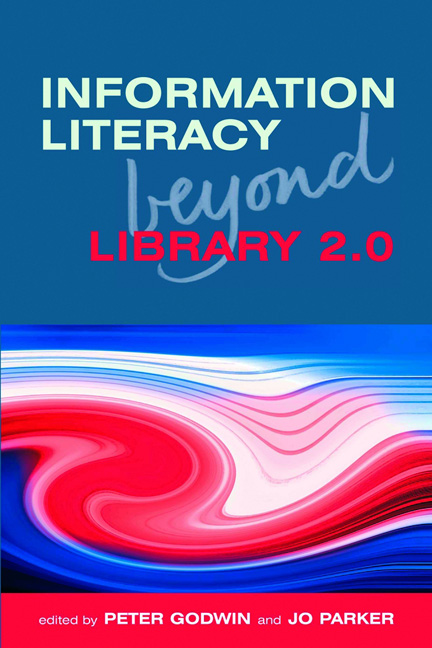Book contents
- Frontmatter
- Contents
- Contributors
- Acknowledgements
- Introduction
- PART 1 RECENT DEVELOPMENTS IN INFORMATION LITERACY AND LIBRARY 2.0
- PART 2 CASE STUDIES
- PART 3 WHAT IT MEANS FOR INFORMATION PROFESSIONALS
- 18 Helping the public online: Web 2.0 in UK public libraries
- 19 Change has arrived at an iSchool library near you
- 20 Information literacy: a path to the future
- 21 Thoughts about the future
- 22 Last word: information literacy beyond Library 2.0
- Index
22 - Last word: information literacy beyond Library 2.0
from PART 3 - WHAT IT MEANS FOR INFORMATION PROFESSIONALS
Published online by Cambridge University Press: 09 June 2018
- Frontmatter
- Contents
- Contributors
- Acknowledgements
- Introduction
- PART 1 RECENT DEVELOPMENTS IN INFORMATION LITERACY AND LIBRARY 2.0
- PART 2 CASE STUDIES
- PART 3 WHAT IT MEANS FOR INFORMATION PROFESSIONALS
- 18 Helping the public online: Web 2.0 in UK public libraries
- 19 Change has arrived at an iSchool library near you
- 20 Information literacy: a path to the future
- 21 Thoughts about the future
- 22 Last word: information literacy beyond Library 2.0
- Index
Summary
Web 2.0 has become social media and is here to stay. The opening up of the web to everyone, and the authoring and sharing capabilities inherent in this, have been embraced by libraries. We may not be speaking about Library 2.0 any more, but the possibilities opened up for libraries have by no means been exhausted. Take-up has been variable and the opportunities for marketing have sometimes obscured the educational possibilities exemplified by IL.
In the past, IL has too often been seen as a higher education (HE) concern. We should see it as a process, from childhood, through school, college, university and into lifelong learning. This only begins to make sense if we always view IL as conditioned by its context: the social conditions, the discipline and the language used within its discourse. IL is a social construct, and what it means to be information literate will vary according to the context. It will even vary according to the individuals within a group, because the participants will be creating their own meaning. The concept of informed learning (see Chapter 6) is helpful here because it explains how students can use information to learn, and then reflect upon their own learning. The curriculum can allow us to use information to develop individual and collective exploration of information, to enable learners to develop their own experience. It is no longer about rote learning, or being directive in terms of the ‘best’ way to do things: we do not write prescriptions, we encourage and guide.
IL is not just for librarians: yet amongst librarians is mostly where it is discussed, and it is rarely discussed outside the library silo. Other players have actually been interested in IL for years, but they call it different things – critical thinking, workplace skills, learning to learn and so on. IL is far more than bibliographic instruction, user education or how to use a library. In our policy documents we may speak about IL, but in our marketing and delivery we adapt our language to suit the consumer. We need to take a broad view, work with colleagues from other departments and be as unafraid of veering into their territory as they often are when they venture into ours. IL is far bigger than librarians, but we are extremely well placed to help with the multifaceted challenge that is 21st-century IL.
- Type
- Chapter
- Information
- Information Literacy Beyond Library 2.0 , pp. 257 - 260Publisher: FacetPrint publication year: 2012

